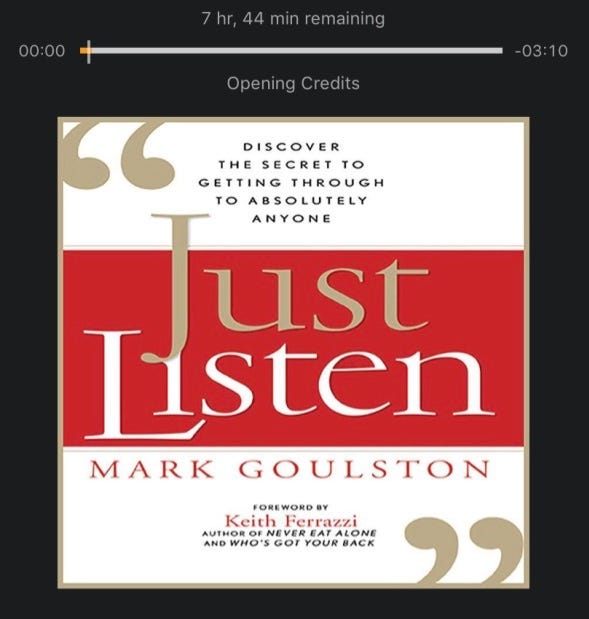Just Listen by Mark Goulston

After enjoying and learning so much from Michael Nichols’ book The Lost Art of Listening, I was excited to find another great one on the same topic. This book ultimately taught me the most about empathizing with others and seeking to just listen, as the title says. This is never an easy thing for me as I often seek to solve things.
It doesn’t matter how much we try to persuade someone that they want a red car if the entire time, all that they want is a blue car. If we never take the time to find out what color car that person wants, we will never be able to help them. Listening is essential and there are many many things that go into effective communication. We all communicate differently and I believe it’s important that we all understand that and take that seriously when we do communicate with people.
Buy-in occurs when: People move from resisting to considering what you say. The key is not what you tell them but is rather what you get them to tell you.
There are many deeper-level things to understand and learn about the parts of the brain but I always appreciate when different snippets are used in books and to provide further context.
3 parts of the brain
1. Primitive reptile layer — fight or flight, acts and reacts
2. More evolved mammal layer — the seed of emotions
3. Prímate layer — logical, weighs different options and generates a conscious plan of action
In conversation, the author shared that typically we tend to naturally classify people and organize people in our minds.
Putting people into mental boxes, typically… GGNEE: Gender, Generation, Nationality/Ethnicity, Education level, Emotion.
The author focused heavily on seeking to understand before being understood. Here are a few things that we can do as listeners to show the speaker that we understand them.
Making someone feel felt:
1. Attach an emotion to what you think the other person is feeling.
2. Say, “I’m trying to get a sense of what you’re feeling and I think it’s… (fill in an emotion) Is that correct? If it’s not, then what are you feeling?” Wait for the person to agree or correct you.
3. Then say, “how… (fill in emotion) are you?” Give the person time to respond and be prepared for a torrent of emotions, at least initially, NOT time to fight back/share your own grievances.
4. Next say, “and the reason you’re so… (fill in emotion) is because…” let the person vent.
5. Then say, “tell me what needs to happen for that feeling to feel better” OR “I’m wondering what needs to happen, what can make it easier?”
6. Next say “What part can I play in making that happen? What part can you play in making that happen?” Example with Debbie…
I love love loved this example. I have heard things about how it’s not the best idea to enter a debate as an outside party in the hopes of mediating. The way that the person below mediated the heated debate was pretty cool and I loved the emphasis that the author placed on what was changed after he spoke.

Warren Bennett is always more interested in you, though he is one of the most interesting people you’ll ever meet. One night, the author was invited to a dinner with some of his close friends who are all thoughtful, smart, and driven. Lively dialogue turned into heated debate, eventually there was more talking than listening, through it all, Warren sat with wrapped attention and said NOTHING. When there was a lull in the conversation and the debating parties paused, Warren stepped in and said to the more unrelenting of the debaters, “Bill, tell me more about that point you made about the philosopher.” By not entering into the debate and allowing one of the participants to exhale, Warren changed the entire tenor of the conversation and made it better.
The goal is to create a safe space for conversation. How many times have you had a conversation with someone where you didn’t feel they truly wanted to hear what you felt or thought? It happens fairly often and many times, people just say they’re fine and carry on. By showing genuine interest and just listening to their responses, we express to them that they matter amongst other things.
Being more interested in others leads them to feel more gratitude and empathy towards you. You lower their brain neuron mirroring deficit.
I bookmarked the following place in the audiobook as there was a list of negative traits that people display at times. The key thing that the author shared is the importance of seeking counsel and understanding what others think of us and about us rather than just trying to determine that for ourselves.
Ask the closest people to you which of these NEGATIVE traits you display and rub people the wrong way.
I next highlighted a part about a way to gain counsel from your employees and overall company in regards to how the CEO or other manager is doing. Do the employees agree? Do they support what’s happening? Maybe most importantly, do they understand? I believe it’s very difficult to support something if you don’t understand it.
The pep CEO challenge: Sending a memo to all employees to gain feedback. Scoring passion, enthusiasm, and pride. Passion is about the vision, enthusiasm is about the execution, pride is about vision and ethics.
Telling someone that they’re not crazy is sometimes most important. It doesn’t matter if you agree with them or not — the focus is on the speaker.
I understand. Tell them their negative thoughts and that you understand rather than trying to just encourage them.
The key here, I’ve learned, is to cater our approach to the person that we’re conversing with. We cannot use hyperboles and repeat what they are saying each time they say something. But, it is important that we understand and that they feel safe, trusted, and understood.
Do you really believe that (repeat what they say)? I understand what you’re saying but I really need to know if that is what you believe, we should clear that up. Are you saying… (hyperbole). Rather than saying, “you said…” Say, “how can I help with this situation?”
I forget exactly what this next highlight was about but I do think it’s definitely a great question, especially with those that we care about.
What’s something fun or important you and I should do in the next 10–15 years?
There are 3 parts of a power thank you but really I think that these can be applied, and should be applied to every thank you. Saying thank you is one thing. Thanking someone for what they did is a whole other thing.
A power thank you
1. Thank someone for something specific
2. Thank them for the effort
3. Tell them about the personal difference it made to you
Next, the author shared the parts of a power apology. This is very very very important. I think that people sometimes completely misunderstand apologies and think people don’t want to talk to you; however, people want acknowledgment. If you need to apologize then you probably hurt that person (I’d assume that they don’t want to be hurt by you again).
The power apology
1. Remorse — demonstrate you know you caused harm
2. Restitution — make amends, at least partially
3. Rehabilitation — don’t do it again
4. Request forgiveness — wait, do it with actions

In closing, this was another great book and one that challenged me. I’ve tried almost all of the things I highlighted and noted from this book. Most valuable to me has been the notes to make someone more felt throughout a conversation. More than anything though, everything I learned can be summed up in two words, just listen.
I gave this book a 4/5